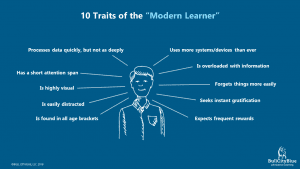By Sue Iannone
You’ve heard about the “Modern Learner” before. It’s a hot topic in the learning and development (L&D) space today. Who exactly is this Modern Learner, and what should be keep in mind as we think about creating training solutions? In this article, we’ll take a brief look at the ten characteristics of Modern Learners and see whether the stereotypes hold up. Then, we’ll outline six tips for reaching them from a training standpoint. Throughout, we’ll draw examples from the world of biopharma L&D.
Ten Traits of the Modern Learner
As we outlined in our previous article, so-called Modern Learners are biologically no different from 18th century learners, 10th century learners, 1st century learners, or any other human learner since Homo sapiens were…well…Homo sapiens. However, our modern world has conditioned many of us to process information and learn in different ways. Based on our experience, the “typical” Modern Learner:
- Processes data quickly, but not deeply
- Has a short attention span and distributes attention thinly
- Is highly visual
- Is easily distracted
- Is found in all age brackets (it’s not just Millennials!)
- Uses more systems and devices than ever and can rapidly switch from device to device
- Is overloaded with information
- Forgets things more easily
- Seeks instant gratification
- Expects frequent rewards

It’s important to note that not every Modern Learner exhibits all of these traits. However, these 10 traits are far more prevalent among learners today than they were even 25 years ago. Our web-enabled, instant-response world has brought huge benefits and increased our productivity greatly, but it has also conditioned us to learn differently than we did in the past.
Reaching the Modern Learner
So, how can L&D tailor its learning programs to best reach Modern Learners? Below are six tips that we’ve found to be very helpful.
- Make it Useful – Learners must be able to apply learning to their jobs. A learning program that isn’t truly useful to the learner—and that only exists to impart less-than-practical knowledge—will not capture a Modern Learner’s time and attention. Examples of useful training topics might include techniques for handling new objections, a new selling tool that will really help increase effectiveness, or interesting new data that reps can present to their customers.
- Keep it Brief – If you can accomplish your training goal in 5 minutes, then don’t take 50. No one ever said, “Hey…Please give me a longer program to sit through!” It’s always best to focus on the core thing(s) the learners need to know and minimize extraneous or “nice-to-know-but-not-vital” information. Deploying a series of mini-modules that leverage microlearning principles might be more effective than a full-day workshop, for example. The learning must be able to be consumed quickly, whether it’s to be used before a learning event, after a learning event, or as a stand-alone module.
- Go Visual – Avoid a lot of text-heavy information in your materials. Where possible, incorporate images, icons, photographs, video, diagrams, and so on. It’s also important to make sure that visuals are attractive and well-organized. Messy visuals and ugly color combinations will drive learners away, but visually appealing design will suck them in.
- Keep Learners Active – Involve the learners, making them active participants rather than passive consumers. From a digital standpoint, this can be done with drag-and-drop activities, interactive rollover / mouseover elements, quizzes, scenario-based questions, and more. In live workshops, you can use role-playing exercises, flip-chart activities, worksheets / work mats, and the like. While interactivity is important, you should also be careful not to overdo it.
- Make Learning Available Everywhere – Modern Learners should be able to access their learning materials in a variety of ways. This includes laptop computers, tablets, and mobile devices. Consider a field-based rep who might have a few minutes here and there to access his learning materials: in the car, while sitting in a waiting room, on a laptop over lunch, or at home. This requires flexible availability at any time.
- “Sell” It – Learners need to know why a training program is needed. L&D must be able to answer—from the learner’s view point—some key questions. Why do I need this? What’s in it for me? How will this help me? It’s also important to “sell” learners’ managers on a program because they can also help sell it to the learners.

Bringing It All Together
A quick example can show how many of these tips can be deployed at once. A customer of ours asked us to update and revamp their disease state training materials for a portfolio of products within a therapeutic area.
The materials they gave us basically consisted of a 90-page PDF document that was very text-heavy and provided extremely in-depth information on the disease state, it’s mechanism of action, and the related anatomy and physiology. It certainly was thorough, but it wasn’t exactly exciting—or quick—to get through.
We took those materials and did the following, all while using the tips above to make the material much more accessible and engaging. We:
- Reduced the volume of content to focus on the important stuff while cutting the extraneous information.
- Broke the content into “bite-sized” chunks.
- Created a series of microlearning digital “mini-modules” that were each brief, highly focused on a core concept, used interactive components to create engagement, and made heavy use of attractive visual elements.
- Made the mini-modules accessible on a variety of devices.
- Structured the mini-modules so that experienced field reps could use them in any order they chose, while suggesting a specific order for new hires.
Needless to say, the revamped training was a big hit. The fact is, the Modern Learner is here to stay, so it makes sense to take that reality into account when developing training. That doesn’t mean L&D needs to cater to “laziness,” but it does mean that L&D needs to be mindful of their audience and develop training that matches how many of us process information these days. Why? Because business outcomes depend on it!


